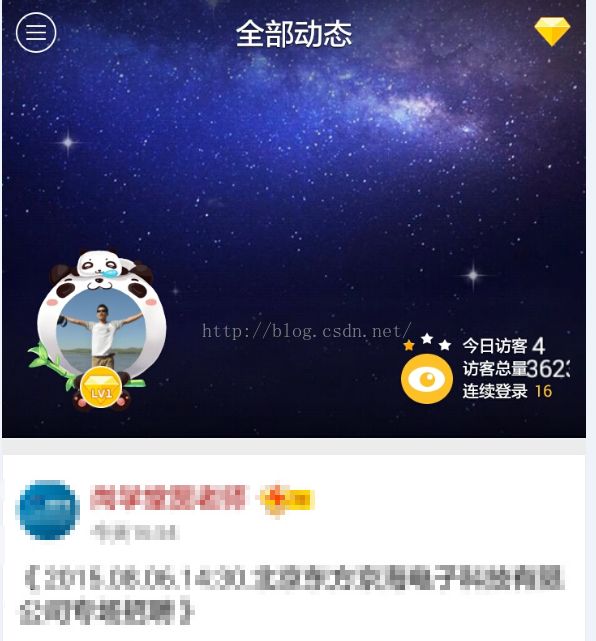PullScrollView进阶(二)----->图片下拉回弹(简易QQ空间下拉效果)
效果是:下拉上边那个图片会相应放大,我主要是实现QQ空间里面那个效果,给出一个思路即可,具体希望网友给出建议
activity_main.xml
<FrameLayout xmlns:android="http://schemas.android.com/apk/res/android"
android:layout_width="match_parent"
android:layout_height="match_parent" >
<ImageView
android:id="@+id/background_img"
android:layout_width="match_parent"
android:layout_height="300dp"
android:layout_marginTop="-100dp"
android:scaleType="fitXY"
android:src="@drawable/pic3" />
<com.example.pullscrollview.CustomScrollView
android:id="@+id/pullscrollview"
android:layout_width="match_parent"
android:layout_height="match_parent" >
<ImageView
android:layout_width="match_parent"
android:layout_height="match_parent"
android:layout_marginTop="100dp"
android:scaleType="fitXY"
android:src="@drawable/pic3" />
</com.example.pullscrollview.CustomScrollView>
</FrameLayout>
MainActivity
package com.example.pullscrollview;
import android.app.Activity;
import android.os.Bundle;
import android.view.Menu;
import android.view.MenuItem;
import android.widget.ImageView;
public class MainActivity extends Activity {
@Override
protected void onCreate(Bundle savedInstanceState) {
super.onCreate(savedInstanceState);
setContentView(R.layout.activity_main);
ImageView background_img = (ImageView) findViewById(R.id.background_img);
CustomScrollView customScrollView = (CustomScrollView) findViewById(R.id.pullscrollview);
customScrollView.setmHeaderView(background_img);
}
}
CustomScrollView
package com.example.pullscrollview;
import android.content.Context;
import android.graphics.Rect;
import android.support.v4.content.ContextCompat;
import android.util.AttributeSet;
import android.util.Log;
import android.view.MotionEvent;
import android.view.View;
import android.view.animation.AnimationSet;
import android.view.animation.TranslateAnimation;
import android.widget.ScrollView;
public class CustomScrollView extends ScrollView {
// 图片控件视图
private View mRootView;
// 用来保存手指的当前位置坐标值
private int mpreY = 0;
// 初始化图片视图的矩形区域坐标位置
private Rect mNormalRect;
private Context context;
// 底部图片
private View mHeaderView;
/**
* 构造器
* @param context
* @param attrs
*/
public CustomScrollView(Context context, AttributeSet attrs) {
super(context, attrs);
this.context = context;
}
/**
* onFinishInflate()函数,明显是在布局解析结束后会调用的函数。
* 获取scrollView的孩子view控件
*/
@Override
protected void onFinishInflate() {
mRootView = getChildAt(0);
super.onFinishInflate();
}
/**
* dp转px
*/
public static int dip2px(Context context, float dpValue) {
final float scale = context.getResources().getDisplayMetrics().density;
return (int) (dpValue * scale + 0.5f);
}
/**
* 根据手机的分辨率从 px(像素) 的单位 转成为 dp
*/
public static int px2dip(Context context, float pxValue) {
final float scale = context.getResources().getDisplayMetrics().density;
return (int) (pxValue / scale + 0.5f);
}
public void setmHeaderView(View view) {
mHeaderView = view;
}
/**
* 在onTouchEvent()中根据手指的移动距离,通过layout()函数将布局跟随移动即可
*/
@Override
public boolean onTouchEvent(MotionEvent event) {
switch (event.getAction()) {
case MotionEvent.ACTION_DOWN: {
// 获取手指当前的位置y轴坐标
mpreY = (int) event.getY();
if (mRootView != null) {
// 进行布局位置--获取图片初始化的矩形区域
mNormalRect = new Rect(mRootView.getLeft(), mRootView.getTop(),
mRootView.getRight(), mRootView.getBottom());
Log.e("TAG", ""+px2dip(context, mRootView.getTop()));//100dp
Log.e("TAG", ""+px2dip(context, mRootView.getBottom()));//612dp
}
}
break;
case MotionEvent.ACTION_MOVE: {
//获取目前的移动的y轴值
float curY = event.getY();
// 获取手指移动的距离--乘以0.25是凸显阻尼效果
int delta = (int) (curY - mpreY);
// 根据手指滑动的距离,进行重新布局那个图片View控件!!!!!!!!!!!!
//将移动的距离转为dp进行判断
int deltaDP = px2dip(context, delta);
int deltaPx = dip2px(context, 100);
if (deltaDP <= 100) {
mRootView.layout(mRootView.getLeft(), mNormalRect.top + 2
* delta, mRootView.getRight(), mNormalRect.bottom + 2
* delta);
mHeaderView.layout(mRootView.getLeft(), dip2px(context, -100)
+ delta, mRootView.getRight(), dip2px(context, 200)
+ delta);
} else {
mRootView.layout(mRootView.getLeft(), mNormalRect.top + 2
* deltaPx, mRootView.getRight(), mNormalRect.bottom + 2
* deltaPx);
}
}
break;
case MotionEvent.ACTION_UP: {
//回归
mHeaderView.layout(mRootView.getLeft(), dip2px(context, -100),
mRootView.getRight(), dip2px(context, 200));
// 回归到初始化的那个矩形位置即可
mRootView.layout(mNormalRect.left, mNormalRect.top,
mNormalRect.right, mNormalRect.bottom);
}
break;
}
// 保存每次手指移动的最新位置
return super.onTouchEvent(event);
}
}
